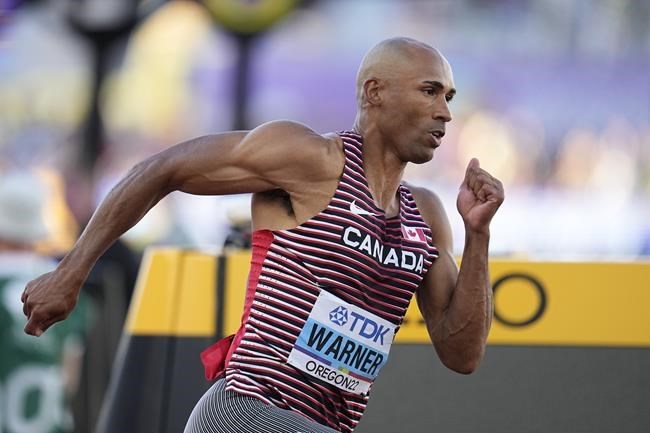TORONTO — Damian Warner would have loved to have been at Hayward Field to watch his friends complete Day 2 of the decathlon at the world championships.
But while they were running the 1,500 metres, the decathlon's final event, he was in an MRI machine for the second time that day. They'd mistakenly done an MRI of his hip earlier.
Warner's quest for a first world decathlon title ended with a hamstring injury in the 400 metres in Eugene, Ore. Canada's Olympic champion was a puddle of tears in coach Gar Leyshon's arms afterward.
"It's just something that I cared about," Warner said, on the emotions. "Thinking about going to the world championships — any world championships — is a big deal, but one in North America was a first time for me."
The tears were because his partner Jen Cotten, their son Theo, and his coaches Gar Leyshon, Dennis Nielsen and Dave Collins were all there with him, which never happens.
And he was leading after four events, and in the shape of his life, he said, "where I genuinely believed that I was going to become a world champion.
"And when that happened, it was like, 'Woah, it's done.' When something you care about gets taken away from you, it's tough to deal with," Warner said. "I think back to 2018, at the Commonwealth Games where I was leading, and I no-heighted in the pole vault. It was a very similar feeling where it’s done. There's no redemption. There's no chance to get this back. You just have to live with the result."
Almost two weeks later, the 32-year-old had just completed his first rehab session back home in London, Ont., and in a phone interview with The Canadian Press, he talked about the frustration around his injury, caused largely, he and his coaches believe, by having to run in Lane 1. But he's also thankful the injury, diagnosed as a Grade 1 hamstring strain, wasn't worse.
"I felt three sharp steps," Warner said of his injury that occurred at the 120-metre mark. "After the first (step), I thought maybe it would go away. And then it got worse and worse and it was like OK, I have to make sure that I don't destroy my hamstring trying to finish this race."
International tracks have nine lanes. Because Lane 1 is always the most worn, plus the fact tighter corners make for slower times, it usually isn't used for the 400. Plus, major international meets seed the heats so the fastest runners get the best lanes.
"I was never worried about getting injured. I was worried about the effect that it would have on my time," Warner said. "You can never know 100 per cent, it could have been something that was lingering and happened. But I believe that if I was in say Lane 8, this wouldn't have happened."
Warner is the world's fastest active decathlete over 400 metres. The torque on his six-foot body while exploding around a tight corner is a recipe for disaster.
Leyshon called it a "concatenation of little things that added together to make one thing blow up at the end."
There also wasn't a full oval warm-up track — just a straightaway — so Warner couldn't warm up on the corner.
Warner was gutted when he finally found Leyshon after the race.
"As soon as he saw me, he burst into tears. I felt terrible for him. I've never seen him like that. He put a lot of emotional energy into this. He was on such a roll. We were all there. Except for the Pan Ams (in Toronto) in 2015, it was his first chance to perform in North America.
"I understand it, when you compete so infrequently, and that's his sixth world championships and he still hasn't won it."
Warner said Theo, who was born in March of 2021, provided a welcome distraction the next day.
"That's the really cool thing about a little kid is they have no idea what happened, they just want to play and get piggybacks," Warner said.
Theo is an "absolute growing concern," Leyshon said with a laugh. "Every five seconds he goes: 'Running?' 'Ball?' He pretends he's in the starting blocks. He throws everything like it's a discus. He loves stones, he picks them up and then he spins around and throws. That was exactly what (Warner) needed."
But not being able to return to the track for Day 1 was tough.
"It hurt him because he didn't get the closure," Leyshon said. "He didn't get to go back and see everybody, didn't get to cheer Pierce (LePage, Canada's silver medallist). He didn't get to slap a buddy on the back, or have people say, 'Oh, I'm sorry,' all that kind of stuff. He just disappeared."
Then, if things weren't bad enough, Warner, Cotten and their son all contracted COVID-19, and spent the next five days in their hotel room before flying home.
Warner and Leyshon are already looking ahead, mapping out the next three years. They'll skip the world indoor championships. Because COVID-19 delayed the 2022 worlds in Eugene by a year, there's another worlds next summer in Budapest. Then there's the 2024 Paris Olympics, and Leyson said Warner might compete in the 2025 worlds.
"I'm looking forward to get back out there with the guys and show them what I could do," Warner said. "That's the beautiful thing, when you look at the bright side, is that normally I'd have to wait a couple of years for a world championship … so again, the situation could be worse. From a bad situation, this seems like the best it could possibly be.
"So, just continue to improve and we will be there in Hungary."
This report by The Canadian Press was first published Aug. 4, 2022.
Lori Ewing, The Canadian Press



